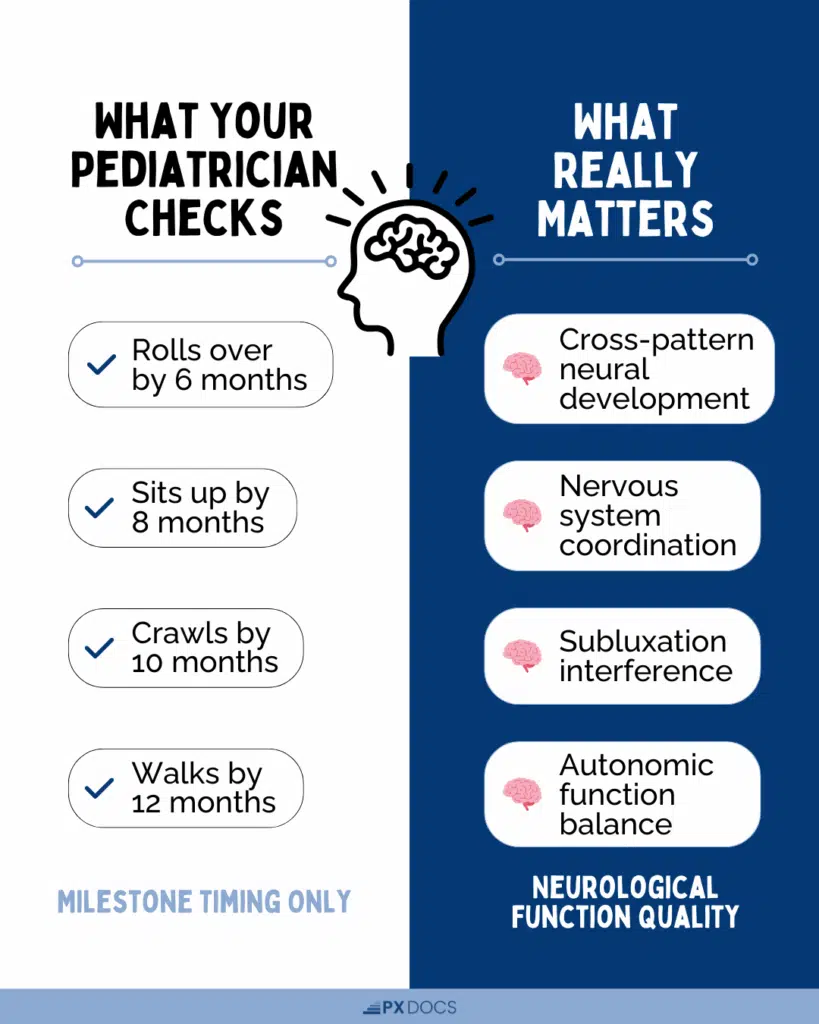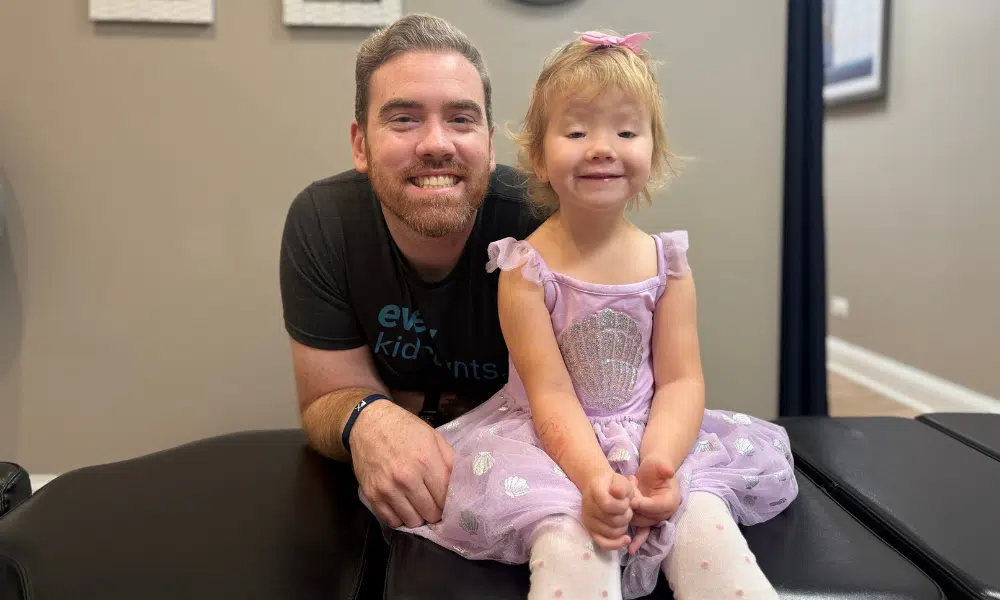Within the first year of life, your baby’s brain will double in size and form over 1 million neural connections every second, making this the most critical period for neurological development in their entire lifetime.
As a new parent, you’ve probably been bombarded with advice on feeding, sleep training, and milestone checklists. You track your baby’s first smiles and rolls, but what if you sense something isn’t right? If your baby struggles with feeding, sleeps poorly, or is fussy, you might find little reassurance from your pediatrician, who often suggests “wait to see” or “they’ll grow out of it”.
The problem with conventional pediatric care is that it focuses on whether your baby hits basic milestones within a specific time period, not on how well their nervous system is actually developing and functioning, and why milestones truly matter. A baby can technically “pass” their developmental checkpoints while still having underlying neurological dysfunction that will impact their health, learning, and behavior for years to come.
As PX Docs, we take a different approach. Through Neurologically-Focused Chiropractic Care, we understand that every milestone your baby reaches represents a complex neurological achievement. By assessing and supporting your baby’s nervous system development from birth, we can help ensure they’re not just meeting milestones, but building the strong neurological foundation they need to thrive throughout their entire life.
What Is “The First Year of Life” from a Neurological Perspective?
When we talk about your baby’s first year of life from a neurological perspective, we’re referring to the most critical window for brain and nervous system development that will ever exist outside of the womb. This isn’t just about learning to smile, sit, or walk; it’s about your baby’s nervous system establishing the fundamental patterns of function that will influence every aspect of their health for the rest of their life!
During this remarkable period, your baby’s brain undergoes rapid neuroplasticity, with the peak of synapse formation, meaning it has an extraordinary ability to form new neural pathways and adapt to its environment. However, this same neuroplasticity that makes incredible development possible also makes your baby’s nervous system uniquely vulnerable to dysfunction.
Subluxation—areas of neurological interference and stuck on stress from prenatal stress, birth trauma, etc. —and dysautonomia—imbalance between the “gas pedal” and “brake pedal” of the nervous system—can develop early and create lasting patterns of dysfunction if not addressed.
The first year can be broken down into critical neurological periods:
- The first three months focus on regulation and basic survival functions
- Months three through six establish motor foundations
- Months six through nine integrate complex movement patterns
- Months nine through twelve develop sophisticated coordination and communication skills
Each phase builds upon the previous one, creating a cascade of development that relies on proper nervous system regulation.

As PX Docs, we’ve seen that the sequence of development matters far more than the speed. A baby who rolls at four months but skips crucial tummy time and head control development may actually be compensating for underlying neurological dysfunction, setting them up for challenges later in life.
The Hidden Neurological Significance of Baby’s First Milestones
Most parents celebrate when their baby first latches successfully, rolls over, or takes their first steps. But what many don’t realize is that each of these seemingly simple milestones represents an incredibly complex neurological achievement that reveals vital information about how well your baby’s nervous system is developing.
0-2 Weeks: Latching & Feeding as Neurological Assessment
Your baby’s ability to breastfeed effectively is actually their first major neurological test. The coordination required for the suck-swallow-breathe pattern involves multiple cranial nerves, upper neurospinal alignment, and precise timing between the nervous system and neuromuscular coordination.
When we see feeding difficulties—shallow latch, frequent popping off, gasping during feeds, or a baby who becomes excessively exhausted while eating—these are often early signs that the nervous system needs support.
As PX Docs, we’ve seen countless babies whose feeding struggles resolved once we addressed subluxation in the nervous system, areas commonly affected during birth.
3-5 Weeks: First Developmental Leap – “Changing Sensations”
During weeks three through five, your baby experiences their first major developmental leap called “Changing Sensations.” They become more alert, notice sounds and lights more acutely, and sleep less. This neurological maturation often comes with increased fussiness, especially around week five, and growth spurts that demand more frequent feeding.
8-12 Weeks: Motor Control Foundations
The development of stable head control between 8-12 weeks is crucial. This milestone indicates that your baby’s cervical spine and deep neck muscles are developing properly. Challenges here—like persistent head turning to one side, difficulty with tummy time, or asymmetrical movement—can signal early neurological dysfunction that will impact every subsequent developmental stage.
4 Months: Major Neurological Maturation
The four-month mark brings significant neurological maturation. Your baby should begin rolling front to back, engaging in “conversations” with babbling, and developing better visual tracking. The so-called “4-month sleep regression” isn’t actually a regression—it’s evidence of major neurological reorganization as primitive reflexes begin integrating and more mature movement patterns emerge.
6 Months: Sitting & Solids
Sitting with support at around six months demonstrates core stability and neurospinal development. This is also when teething may become apparent and your baby starts exploring solids, requiring increased neurological coordination for these new skills.
9-10 Months: Crawling + Cruising
The most neurologically significant milestone of this period is crawling, typically emerging between 7-10 months. Crawling isn’t just about mobility—it’s about establishing cross-pattern movement that stimulates balanced development of the corpus callosum, facilitating communication between the brain’s hemispheres. This builds a foundation for skills such as walking and reading.
As PX Docs, we’ve observed that babies who skip crawling or crawl asymmetrically often struggle later with learning challenges, coordination difficulties, and behavioral regulation. The nervous system connections built during proper crawling simply cannot be replicated by any other developmental activity.
11-12 Months: First Steps + First Words
When your baby takes their first steps between 9-12 months, they’re demonstrating sophisticated balance, coordination, and confidence, all neurological achievements that depend on every previous milestone being built on a strong foundation.
The “Perfect Storm” That Disrupts Optimal Development
As PX Docs, we use the term “Perfect Storm” to describe how multiple stressors can accumulate and overwhelm a baby’s developing nervous system, creating patterns of dysfunction that persist long after the initial stressors have passed. Understanding these factors isn’t about creating fear or guilt; it’s about recognizing why some babies struggle more than others and how we can support their recovery.
Prenatal Stressors
Even before birth, your baby’s nervous system can be impacted by factors like preconception and fertility stress, prenatal stress, the mom’s nervous system, and the overall environment during pregnancy. Research shows that chronic stress during pregnancy affects fetal brain development, while positioning issues can create tension patterns in your baby’s neurospinal system and, in turn, the nervous system.
Birth Interventions and Their Neurological Impact
While medical interventions during birth are sometimes necessary and life-saving, it’s important to understand their potential impact on your baby’s nervous system:
Common interventions that can affect mom and baby include:
- Pitocin for induction, which creates stronger, more frequent contractions
- IV fluids and epidural anesthesia
- Forceps or vacuum delivery, which places significant pressure on baby’s head and neck
- Episiotomy and membrane sweep
- Restricted food or drink during labor
Interventions specifically for babies often include:
- Fetal heart monitoring (internal or external)
- Erythromycin (eye goop) and suctioning of airways
- Vaccines: Hep B and Vitamin K shot at birth
- Extended time away from mother for procedures
- Birth tools: hands, forceps, vacuum
Environmental Stressors in Early Life
After birth, factors like disrupted sleep patterns, overstimulation from modern environments, early antibiotic exposure, and feeding challenges can continue to stress an already vulnerable nervous system. Each additional stressor can push a baby’s nervous system further into sympathetic dominance, which is when the Sympathetic Nervous System gets stuck in “fight or flight” mode when they should be in a calm, regulated state that supports optimal development.
How Conventional Medicine Misses the Neurological Foundation
While conventional pediatric care excels at identifying severe developmental delays and medical emergencies, it often misses the subtle neurological dysfunction that can significantly impact your baby’s health and development, not only now but in the future as well. The current medical model focuses primarily on whether babies hit basic milestones within broad time ranges, rather than assessing how well their nervous system is actually functioning.
Your pediatrician might check off that your baby can roll over at six months, but they’re not assessing whether that rolling movement is symmetrical, coordinated, or built on proper foundational development. A baby can technically “pass” their developmental screening while compensating for underlying neurological dysfunction through tension patterns, asymmetrical movement, or skipped developmental stages.
When parents express concerns about feeding difficulties, sleep issues, excessive crying, or developmental quirks, they’re often told these are “normal variations” or advised to “wait and see” if the child outgrows them. This approach misses the critical window when neuroplasticity is at its peak and gentle interventions can have the most profound impact.
What conventional pediatric care consistently overlooks is the assessment of subluxation and dysautonomia—the neurological interference and imbalance that can develop from the Perfect Storm of stressors. These functional problems rarely show up on standard tests but can profoundly impact how well your baby eats, sleeps, develops, and regulates their emotions and behavior.
PX Docs’ Neurologically-Focused Approach to the First Year
At PX Docs, we use advanced INSiGHT scanning technology to objectively assess your baby’s nervous system function. These gentle, non-invasive scans measure heart rate variability, muscle tension patterns, and temperature regulation—giving us a clear picture of where stress and dysfunction exist in your baby’s nervous system.
In a healthy, well-regulated infant, these scans show balanced, symmetrical patterns. When we see areas indicating stress or dysfunction, we know exactly where the nervous system needs support.
Chiropractic adjustments for infants require specialized training and an incredibly gentle touch, often no more pressure than you’d use to check the ripeness of a tomato. These precise adjustments help remove neurological interference, allowing your baby’s nervous system to function optimally during this critical developmental period. At PX Docs, we’ve seen remarkable improvements in feeding, sleeping, and development when subluxation is addressed early.
Our care adapts to each developmental phase your baby goes through. During the early weeks, we focus on supporting regulation and feeding function. As your baby grows, we ensure their nervous system can handle the increasing demands of motor development, sensory processing, and social interaction. Rather than waiting for problems to develop, we take a preventive approach—supporting optimal function from the very beginning.
Practical Guidance for Parents
Trust your “mom gut” and parental instincts. If your baby struggles with feeding, seems constantly unsettled, has difficulty sleeping, or shows asymmetrical movement patterns, these may be early signs of nervous system dysregulation. Other red flags include persistent head turning to one side, excessive arching or stiffening, difficulty with tummy time, or missing developmental milestones in sequence.
You can support your baby’s developing nervous system through proper positioning during sleep and play, plenty of skin-to-skin contact, and minimizing overstimulation. Breastfeeding provides not just nutrition but also important neurological stimulation and co-regulation. Regular tummy time builds crucial nervous system, neck, and core strength, while limiting time in containers like car seats and bouncers when not necessary, allowing for natural movement development.
When to Seek Neurologically-Focused Care
The ideal time for initial evaluation is within the first few days or weeks of life, especially if there were any complications during pregnancy or birth. However, it’s never too late to support your baby’s nervous system development. If you notice any concerns about feeding, sleeping, pooping, development, or regulation, seeking assessment sooner rather than later takes advantage of your baby’s incredible neuroplasticity during this critical period.
Your Baby’s Neurological Foundation Starts Now
Your baby’s first year represents the greatest opportunity you’ll ever have to positively influence their neurological development and long-term health. The investment you make in your baby’s nervous system health during their first year pays dividends for their entire lifetime. Children who receive early neurological support often show better learning abilities, improved behavior regulation, stronger immune function, and greater resilience to stress as they grow.
Remember that hitting milestones on schedule isn’t enough—the quality of neurological function underlying those milestones matters just as much. If you sense something isn’t quite right with your baby’s feeding, sleeping, pooping, or development, trust those instincts. Your baby’s nervous system has an incredible capacity for healing and optimization, especially during this critical first year.
We encourage you to visit the PX Docs directory and find a practitioner in your area who can support your baby’s neurological function. Your baby isn’t just learning to eat, sleep, poop, and move—they’re building the neurological foundation that will serve them for their entire life.
The first year goes by quickly, but the neurological patterns established during this time last forever. Give your baby the gift of a strong, well-functioning nervous system from the very beginning.





